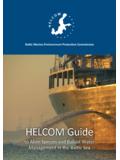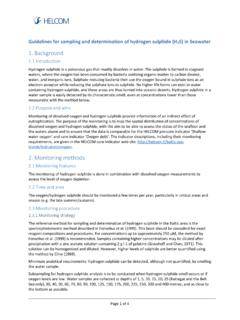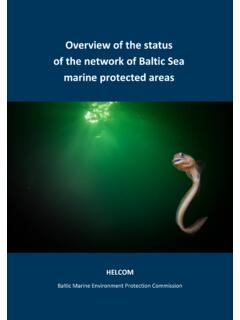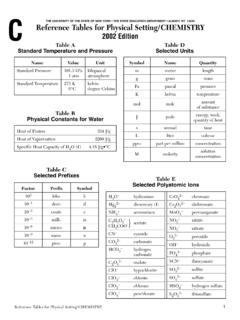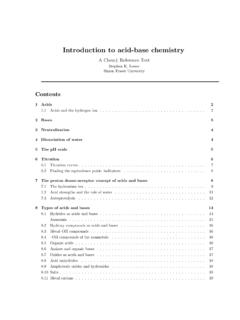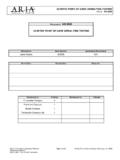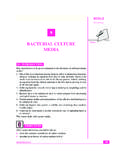Transcription of Draft guidelines for sampling and determination of total ...
1 Draft guidelines for sampling and determination of total alkalinity 1 Background Introduction Although not listed among HELCOM Core Indicators, total alkalinity should be monitored to provide information of alterations in the carbonate buffer system, which may be induced by changing weathering processes on the continents or internal processes in the Baltic Sea. Although alkalinity is not affected by increasing atmospheric CO2, it controls the pH at a given atmospheric CO2 level. Hence its long-term changes are interacting with ocean acidification induced by the dissolution of anthropogenic CO2. Purpose and aims The aim of monitoring is to identify spatial variations and temporal trends in total alkalinity . 2 Monitoring methods Monitoring features total alkalinity (AT) is defined as amount of protons required to compensate the excess of proton acceptors over proton donors (hydrogen ions)1 kg of seawater. For a full definition and an overview of contributing ion species, see Dickson (1981).
2 Time and area Monitoring of total alkalinity is carried out by several HELCOM contracting parties, and the monitored area covers the entire Baltic Sea area, both the open sea and coastal areas. Monitoring procedure Monitoring strategy When studies of the carbonate buffer system are performed, four variables are considered: total alkalinity (AT), pH, dissolved inorganic carbon (DIC) and partial pressure of carbon dioxide (pCO2). Theoretically, when two of these components are accurately determined, the remaining two can be calculated. These calculations, while valid for oceanic water, does not take into account contributions from dissolved organic material. The conditions in the Baltic Sea with relatively high levels of humic matter and other dissolved organic components are more complex (Kuli ski et al 2014, Ulfsbo et al 2015). This results in calculated AT values that are lower than those obtained from measurements. This has to be taken into account when determining the state of the marine CO2 system based on AT measurements.
3 alkalinity should be determined by potentiometric titration, with an appropriate endpoint determination . Water samples are collected from discrete depths, and analysed. Samples can be stored a limited time after sampling . Samples are collected at depths of 1, 5, 10, 15, 20, 25 (Kattegat and the Belt Sea only), 30, 40, 50, 60, 70, 80, 90, 100, 125, 150, 175, 200, 225, 250, 300 and 400 metres; and as close to the bottom as possible. sampling method(s) and equipment Samples should be collected into gas-tight capped glass bottles (e. g. Pyrex bottles). Bottles should be rinsed with sample water before filling. Since alkalinity is not changed by the addition/removal of gaseous CO2, either by gas exchange or biological activity, it is not necessary to avoid contact with ambient air. However, there is one exception: Ulfsbo et al. (Mar. Chem., 2011) reported that the monitoring alkalinity Page 1 of 4. guidelines for sampling and determination of total alkalinity data for H2S-containing waters which they used in their study, were biased due to the oxidation of H2S by contact with ambient air.
4 A head space of 1 % with respect to the total sample volume is already sufficient to oxidize approximately 50 mol-H2S/l. This has to be taken into account when determining the alkalinity in anoxic waters. For general requirements for sampling , preservation, handling, transport and storage of water samples, see EN ISO 5667-3 and EN ISO 5667-9. Sample handling and analysis Sample handling Since biological consumption/generation of CO2 does not affect the alkalinity , it is not necessary to poison the samples before storage. Nevertheless, it is recommended to store the samples at low temperatures and darkness, and to analyze the samples within a few weeks in order to avoid any other (unknown). biogeochemical reactions that may affect the alkalinity . Analytical procedure A known amount of sample is titrated with a solution of hydrochloric acid until the equivalence point can be calculated. Titration procedure is monitored with a pH glass electrode. Titration is continued until a final pH of approximately Calibration of the electrode is not necessary as long as IRM or CRM are analysed, but the electrode and temperature probe should be rinsed with deionized water and wiped between calibrants/samples.
5 In a controlled laboratory environment, an analytical balance is used for determination of sample size. If the analytical procedure is performed on board a vessel during a sampling cruise, it is better to use a volumetric method. Density of the sample water is calculated from temperature and salinity. Automated burettes are commercially available, as well as software for data collection and processing. Hydrochloric acid, is used for the titration. The titer of the hydrochloric acid needs to be correctly determined; ampoules of hydrochloric acid with certified concentration are commercially available. Data analysis When density of seawater is used for calculations, equation of state of seawater (Millero and Poisson1981). should be used. 3 Data reporting and storage Data should be reported as mol kg-1. Data is reported annually to the HELCOM COMBINE database, hosted by ICES. 4 Quality control Quality control of methods Laboratories carrying out determination of total alkalinity should have established a quality management system according to EN ISO/IEC 17025.
6 Collect and analyze samples for estimation of measurement uncertainty (repeated measurements from a sample, multiple subsamples from different samplers closed at same depth). Equipment used (analytical balance, pH electrode, thermometer probe) must be calibrated and their accuracy monitored. An internal reference material (IRM) should be analyzed daily. Page 2 of 4. guidelines for sampling and determination of total alkalinity A certified reference material (CRM) is provided by Scripps Institute of Oceanography of the University of California, San Diego. It is strongly recommended that all laboratories participate in interlaboratory comparisons and proficiency testing programs, to provide external verification of laboratory performance. Proficiency testings for alkalinity in environmental waters are provided by e. g. SYKE. More proficiency testing schemes are listed at Contracting parties should follow the HELCOM monitoring guideline but minor deviations from this are acceptable if the method achieves comparable results.
7 Validation of the adopted method needs to be performed on the relevant matrix and concentration range by taking part regularly at intercomparison studies or proficiency testing schemes. Quality control of data and reporting Measurement uncertainty should be estimated using ISO 11352. Estimation should be based on within- laboratory reproducibility, IRM, and, if available, data from proficiency testings and CRM. Collected data should be checked for consistency between sampled variables (e. g. total alkalinity and pH;. total alkalinity and salinity). 5 Contacts and references Contact persons Anna Willstrand Wranne, SMHI, Johan H kansson, SMHI, References Andersson L G, Turner D R, Wedborg M and Dyrssen D 1999. determination of total alkalinity and total dissolved inorganic carbon. Chapter 8, p 127-148 in Grasshoff K, Kremling K and Erhardt M (ed). Methods of Seawater Analysis 3rd ed. Wiley-VCH. ISBN 3-527-29589-5. Dickson A G 1981. An exact definition of total alkalinity and a procedure for estimation of total alkalinity and total inorganic carbon from titration data.
8 Deep Sea Research Vol 28A p 609-623. Millero F. J. and Poisson A 1981. International one-atmosphere equation of state of seawater Deep Sea Research Vol 28, p 625 629. EN ISO 5667-3*: Water quality sampling Part 3: Preservation, and handling of water samples EN ISO 5667-9*: Water quality sampling Part 9: Guidance on sampling from marine waters EN ISO 11352*: Water quality Estimation of measurement uncertainty based on validation and quality control data EN ISO/IEC 17025*: General requirements for the competence of testing and calibration laboratories Kuli ski K, Schneider B, Hammer K and Schulz-Bull D 2014. The influence of dissolved organic matter on the acid base system of the Baltic Sea. Journal of Marine Systems vol 132. Ulfsbo A, Kuli ski K, Anderson L 2015. Modelling organic alkalinity in the Baltic Sea using a Humic-Pitzer approach. Marine Chemistry vol. 168 p 18-26. *. For undated references, the latest edition of the referenced document (including any amendments) applies.
9 Additional literature Page 3 of 4. guidelines for sampling and determination of total alkalinity Dickson A G, Sabine C L, Christian J R (ed) 2007. Guide to best practices for ocean CO2 measurements. PICES. Special Publication 3. IOCCP Report No 8. Haraldsson C, Andersson L G, Hassell v M, Hulth S and Olsson K 1997. Rapid, high-precision potentiometric titration of alkalinity in ocean and sediment pore waters. Deep Sea Research Vol 44 p 2031-2044. Page 4 of 4.
